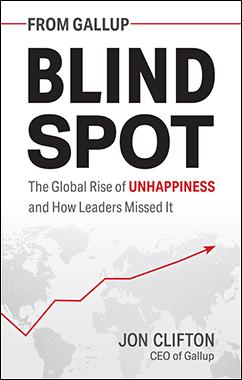Story Highlights
- Unemployment is 3.4%, the lowest in decades
- Only 20% of people are thriving at work which is creating a broken workplace
- The real job crisis is 3.3 billion people want a great job, 91% don’t have one
Your work is going to fill a large part of your life, and the only way to be truly satisfied is to do what you believe is great work.
-- Apple Co-Founder Steve Jobs at the 2005 Stanford University Commencement Address
The world is facing a jobs crisis. But you would never know it by looking at the world’s official unemployment rate. According to the International Labour Organization (ILO), global unemployment has remained around 5% to 6% for the past decade -- a figure that hardly indicates a crisis.
The official unemployment figure hides actual unemployment because of how it is calculated. Real global unemployment may be over 30%. Although this is very concerning, there is an even bigger problem -- the alarming scarcity of great jobs. Of the roughly 3.3 billion people who want a great job, only 300 million have one. This is the real global jobs crisis.
The global unemployment rate should be replaced with a new metric -- the great jobs rate. This metric would hold leaders accountable for what really helps improve people’s lives -- a great job.
The Wrong Jobs Metric
Official global unemployment was 5.4% in 2019, according to the ILO. (The pandemic pushed global unemployment to only 6.6% in 2020 and 6.2% in 2021). This would be a staggering figure if it applied to the entire global population (7.7 billion people), but that is not how unemployment statistics work. Unemployment applies only to the people in the labor force.
The global labor force includes people who are working and people who are looking for work; it does not include children, retired people, students, homemakers, or people who are not looking for work. The global labor force totals 3.3 billion people. A 5.4% unemployment rate means that less than 200 million people are unemployed. A massive number, for sure. But is it a global crisis?
Compared with other global crises, maybe not. Roughly 2 billion people suffer from food insecurity, 1 billion people live in slums or informal settlements, and 2.2 billion people lack safely managed drinking water. In light of these figures, there doesn’t seem to be a problem in the global jobs market. Yet there is -- you just can’t see it in the official unemployment figure.
When thinking of global unemployment rates, you might assume that rich countries have low unemployment rates and poor countries have high unemployment rates. Well, not according to the official unemployment numbers. Developing countries like Niger and Laos have some of the lowest unemployment rates in the world (0.6% and 0.9%, respectively) -- and wealthier countries like France have much higher unemployment rates (8.4%). The unemployment rate for all low-income countries is 4.6%; it is 7.6% for the euro area. When we look at the statistical relationship of GDP per capita and the official unemployment rate for more than 200 countries, they do not correlate.
The countries with the lowest unemployment rates in the world (in 2019) include many developing countries that collectively lack decent work for millions of people. Yet the unemployment rate in each of those countries implies that they all have healthy job markets.
Undercounting the Unemployed
Most countries collect labor force statistics using long surveys administered to tens of thousands of people. These surveys ask individuals how many hours they worked in the past week and whether it was for an employer or for themselves. If they are not employed, people are asked whether they are looking for work. If they did not work any hours and claim that they are looking for work, they are considered unemployed. The resulting data are the official employment statistics for the country.
Now, imagine posing these questions to a subsistence farmer in Africa or someone selling trinkets on the street in India. “Did you work 30 hours or more in the previous week?” Of course they did. Although their work does not meet their basic needs, they still have what global agencies define as work. They are officially “self-employed,” meaning they are not “unemployed.”
This is why unemployment rates are so low in some of the poorest countries in the world. Millions who are truly unemployed are considered self-employed, and their painful work arrangement is evident when you look at their wellbeing. In a previous Gallup analysis, my colleague Jenny Marlar and I found that the self-employed in poor countries reported the lowest wellbeing in the world, even lower than the unemployed.
Some people even believe that unemployment is a “luxury” in lower-income countries because the poor in those countries cannot afford to spend time looking for the right job; only the rich can do that.
Additionally, many lower-income governments do not have enough money to assist the unemployed. According to The Economist:
In many developing countries, unemployment is low simply because few people can afford it. Even when they are available, benefits may not be worth the bother. In Thailand, for example, payments last six months and range from 1,650 baht per month ($52) to 15,000. To be eligible, a Thai worker must register with the social-security office. But only one in three does so ... Many remain outside the formal economy, where they are denied benefits but also spared taxes.
If you live in a wealthy country like the U.S., the term “self-employed” often connotes small-business ownership or entrepreneurship. But again, this is not the reality for many of the self-employed in most countries. In fact, 30% of people who are self-employed globally live in extreme poverty (less than $1.90 per day).
Real Unemployment?
Gallup regularly tracks global employment using a survey that closely follows the standards set by the ILO. It is comparable to the official unemployment rates in many countries, and as I previously reported, it tracks closely with the U.S. BLS data. Our 2019-2021 results were:
- 44% employed full time for an employer
- 22% self-employed
- 13% part time, want full-time work
- 10% part time, do not want full-time work
- 11% unemployed
So, if 22% are self-employed, and 30% of the self-employed live in extreme poverty, we can estimate that at least 6% (30% of the 22%) of the total workforce is incorrectly categorized as “self-employed.” They aren’t entrepreneurs -- they are people who desperately need meaningful work and are doing anything to get by. They are truly unemployed.
If you add 6% to the traditional unemployment figure that we found (11%), real global unemployment would be 17%. But even that is probably an underestimate. Living on less than $1.90 per day is extreme poverty, meaning the number of people who are categorized as self-employed but who are truly unemployed could be far higher.
Lastly, 13% of people have part-time work but want fulltime work. Yet the headline unemployment figure ignores them precisely because they have some work. If they were also considered unemployed, then real global unemployment would be 30%.
But sorting out who has some work and who has no work is not the core of the global jobs crisis. The real problem is the absence of metrics on the quality of someone’s job.
The Global State of Workplace Thriving, Quiet Quitting, and Loud Quitting
The unemployment metric is widely considered the single indicator to understand the health of the jobs market. But what metric captures how workers are feeling?
One of the most significant sources of global misery comes from work. Work is so miserable that when I Googled, “My job is …” the top four results were: “(My job is) too stressful, making me miserable, boring, killing me.”
And work is literally killing people. Three million people die from occupational accidents and work-related diseases each year, according to the ILO. Even if work does not kill you, it can seriously hurt you. Nearly one in five workers -- which translates to about 600 million people -- say they have been seriously injured at some point while working.
But even if work does not injure or kill you, how much psychological damage does it cause? According to the official statistics, we don’t know. Official labor statistics only tell us if people are working, not how they are doing at work.
One attempt to quantify how people are doing at work is a concept known as worker engagement. Or, as Daniel Kahneman said on Adam Grant’s podcast, “My interpretation of (worker) engagement was fairly close to wellbeing at work.” That day, Kahneman was referring to Gallup’s measure for employee engagement, which quantifies wellbeing at work. We find that workers generally fall into three categories -- people are either thriving at work (our technical term for it is “engaged”), quietly quitting (“not engaged”), or loudly quitting (“actively disengaged”).
People who are thriving at work are enthusiastic and passionate about what they do. They enjoy working with their colleagues, have development opportunities, and feel cared about as a person. People who have quietly quit are psychologically detached from their jobs -- they put in the time without energy or passion. Loud quitters are resentful that their needs are not being met and represent the nadir of worker unhappiness.
Whether someone is thriving at work, quietly quitting, or loudly quitting is subjective. And everyone knows how they feel about their job and workplace. But understanding how workers are doing across large companies or even across countries requires having these conversations at scale.
After conducting millions of interviews with workers worldwide, Gallup identified 12 items (known as the Q12) that help succinctly and scientifically measure worker wellbeing at scale. The Q12 allows workers to describe how they are doing at work from their perspective. Workers are asked how much they agree with each of the following statements on a 5-point scale. Their answers also predict future behaviors, such as turnover and productivity.
This list represents 12 of the most important emotional needs of a worker. Those needs include having the opportunity to learn and grow, getting meaningful recognition for doing good work, and even having a best friend at work -- which is one of the single biggest predictors of whether someone will stay at a job.
Look at the first item -- “I know what is expected of me at work.” Half of workers do not strongly agree with that item. Imagine showing up to work every day and not knowing what you are supposed to do. It must be frustrating, confusing, or completely maddening, and that is how half of the world’s workforce feels when they go to work.
Now look at the third item -- “At work, I have the opportunity to do what I do best every day.” Less than one-third of workers strongly agree with that item. They are doing a job that does not allow them to use their strengths. Again, imagine coming in to work every day and constantly being told to do things you are not very good at or that you don’t like doing. This emotional detachment adds to the world’s misery, and leaders miss it because they do not focus on how people feel in the workplace.
The World’s Broken Workplace
Despite the importance of wellbeing at work, very few leaders make it a priority. After posing the Q12 to the world, Gallup finds that only 20% of all people are thriving at work, while 62% have quietly quit and 18% have loudly quit.
And the misery that those 18% of workers feel consumes a massive part of their lives. According to one estimate, the average person spends 115,704 hours of their life at work. That is the equivalent of more than 13 years. The only thing we spend more time doing is sleeping (about 33 years).
If people truly spend that much time working, it’s no surprise that how a person feels at work hugely affects their overall life. If you are thriving at work, you rate your overall life significantly higher compared with someone who is miserable at work. But thriving at work not only improves how you see your life, you also live a better life.
Gallup finds that if you are thriving at work, you experience far less stress, sadness, anger, pain, and worry every day compared with someone who has loudly quit. Thriving at work even enhances how much joy, laughter, respect, and intellectual stimulation you experience.
Having your emotional needs met at work changes everything. For instance, when we surveyed German working adults, 81% of thriving workers reported having fun at work in the past week, compared with only 10% of loud quitters. The loud quitters' misery even follows them home.
Fifty-nine percent of loud quitters say that in the past month, they had three or more days when the stress of work caused them to behave poorly with their family and friends. Being miserable at work can even make your life worse than having no work at all. Loud quitters not only rate their lives worse than the unemployed, they experience worse lives. Loud quitters are more likely than the unemployed to report anger, stress, physical pain, and worry, and less likely to report positive experiences such as enjoyment, respect, intellectual stimulation, and laughing and smiling a lot.
The World’s Official Statistics for Great Jobs
The official unemployment rate fails workers for two reasons: It doesn’t capture real global unemployment, and it doesn’t capture the misery in the workplace. The solution? Change the metric used for the health of the jobs market. Instead of working to lower the 5.4% global unemployment rate, world leaders should work on increasing the global great jobs rate, which today stands at 9%.
I’m going to show you how I calculated the global great jobs rate -- and you may not fully agree with how I arrived at the number. But I hope this initial thinking will inspire someone to create a more perfect great jobs indicator.
First, let’s define a good job and a great job. Gallup considers a good job to be steady work of at least 30 hours per week and a paycheck. A great job is steady work, a paycheck, and a job where the worker is engaged -- they can use their strengths, their opinions count, and they have a manager who cares about their development.
Now, the math: There are about 7.7 billion people on the planet, and roughly 5.4 billion of them are adults. And 3.3 billion of those adults want a great job.
Out of the 3.3 billion who want a great job, roughly 1.5 billion have a good job (steady work and a paycheck). If 20% of those with a good job are thriving at work, that means about 300 million workers have a great job.
But that also means that out of the roughly 3.3 billion people who want a great job, 91% of them don’t have one. That is the real global jobs crisis.
The current global unemployment metric holds leaders accountable to the lowest common denominator for jobs. The message is: “Let’s get the number of people with no work to the lowest percentage possible.” Instead, the message should be: “Let’s get the number of people with great jobs to the highest percentage possible.”
Every week, The Economist publishes a page in the back of its magazine that is called “Economic data, commodities and markets.” The page lists the GDP, consumer prices, and unemployment rates from 40 of the world’s largest economies.
But what if one day they just quit reporting those unemployment rates and instead reported only the great jobs rates? If they did, it would hold leaders responsible for getting everyone great work, which is what really makes a great life.
This article was first published on LinkedIn and is adapted from Gallup's latest bestselling book Blind Spot: The Global Rise of Unhappiness and How Leaders Missed It, now available in audiobook.
Get your copy of Blind Spot: the Global Rise of Unhappiness and How Leaders Missed It to learn why and how leaders should measure citizen wellbeing and happiness.
The Gallup Q12 items are Gallup proprietary information and are protected by law. You may not administer a survey with the Q12 items or reproduce them without written consent from Gallup. Copyright © 1993-1998 Gallup, Inc. All rights reserved.





